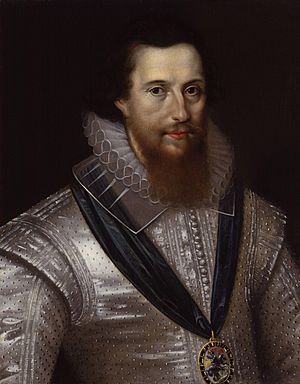Essex's Rebellion facts for kids
Essex's Rebellion was a failed uprising in 1601. It was led by Robert Devereux, 2nd Earl of Essex, against Queen Elizabeth I of England. Essex wanted to gain more power and influence in the Queen's court. He was also against a group led by Sir Robert Cecil.
Why the Rebellion Started
Robert Devereux, 2nd Earl of Essex (1565–1601) was the main leader of this rebellion. Problems began in 1599 when Essex was sent to Ireland. His job was to stop a rebellion led by Tyrone. Essex led a very large army, one of the biggest ever sent to Ireland.
Everyone expected Essex to quickly stop the rebellion. But he fought many battles that didn't achieve much. He also spent a lot of money. He couldn't defeat the Irish forces. Because of these problems, Essex made a truce (a peace agreement) with Tyrone. This truce made England look bad. It also challenged the Queen's authority. Essex then left Ireland and returned to England. This was against the Queen's direct orders.
His time in Ireland was a disaster for him. The Queen said his actions were "dangerous and disrespectful." In June 1600, Essex lost his important jobs. He was also placed under house arrest. Essex had hoped to guide England's foreign policy. He also secretly wanted to help James VI of Scotland become the next King of England.
Essex felt very upset after losing his position. He thought the Cecil family group was against him. He worried about his safety. He also suspected that Cecil wanted peace with Spain. Essex was now disgraced and had money problems. He wrote many letters to the Queen, asking for forgiveness. By August 1600, he could move freely, but he was not allowed back at court. He kept sending letters to get permission to return. In November 1600, the Queen refused to renew his special right to control the sweet wine trade. This made Essex's money problems even worse. He then started making plans to take control of the court by force.
The Rebellion Begins
Essex's home in London, Essex House, became a meeting place. Many people who were unhappy with Queen Elizabeth's government gathered there. On February 3, 1601, five of the rebellion's leaders met. They met at Drury House, where the Earl of Southampton was staying. Essex himself was not there, hoping to avoid suspicion. The group talked about Essex's plans. These plans included taking over the court, the Tower, and the City. Their goal was to force the Queen to change her government leaders. They especially wanted to remove Sir Robert Cecil. This plan meant they might harm the Queen's people.
On February 7, some of Essex's followers went to the Globe Theatre. They asked the Lord Chamberlain's Men (a theater group) to perform Richard II. They specifically wanted the scene where the king is removed from power. The theater group was unsure about performing such a sensitive play. But they agreed when they were promised 40 shillings (about £2 in 1601 money). This was "more than their ordinary" pay. On the same day, the Queen's advisors, the Privy Council, told Essex to come before them. But he refused. He had lost his chance to surprise the court. So, he decided to try and get the people of London to support him. He claimed that the Queen's government planned to murder him. He also said they had betrayed England to Spain.
Essex and his followers quickly put their plan into action. Around 10 a.m. the next morning, February 8, four important people came to Essex. They included Sir Thomas Egerton, the Lord Keeper. They came in the Queen's name. Essex took these four messengers hostage. Then, he and about 200 followers went to the City of London. They planned their arrival for when a sermon at Paul's Cross would be ending. They expected the Lord Mayor to be there. Meanwhile, Cecil sent a warning to the Lord Mayor. Heralds (official messengers) announced that Essex was a traitor. Once the word "traitor" was used, many of Essex's followers left him. None of the citizens joined him, which he had expected.
Essex's situation was desperate. He decided to return to Essex House. When he arrived, he found that the hostages were gone. The Queen's men, led by the Earl of Nottingham (the Lord High Admiral), surrounded the house. By that evening, Essex surrendered after burning some evidence. Essex, Southampton, and the remaining followers were arrested.
Less than two weeks after the failed rebellion, Essex and Southampton were put on trial. They were accused of treason. The trial lasted only one day. It was clear they would be found guilty. Essex had burned evidence to protect his followers. But a Reverend named Abdy Ashton convinced him to confess. Essex then named everyone involved. This included his sister, Penelope, Lady Rich. He mentioned her as being very involved, but no action was taken against her.
What Happened Next
On February 25, 1601, Essex was executed by beheading. This happened inside the Tower of London. He was buried there in the Church of St Peter ad Vincula. The government worried that people might feel sorry for Essex. So, they made sure the preacher at Paul's Cross explained Essex's confession and execution carefully.
Southampton and Sir Henry Neville survived their time in the Tower. They were set free when James I became king. Sir Christopher Blount, Sir Gelli Meyrick, Sir Henry Cuffe, Sir John Davies, and Sir Charles Danvers were also tried for treason on March 5, 1601. All were found guilty. Davies was allowed to leave. But the other four were executed. However, there were no large-scale executions. The other people involved in the rebellion were simply made to pay fines.


